Artopia: October 2006 Archives

John Perreault: View from Hilton Hotel Window, Houston, Texas, 2006
Against Nostalgia
At the American Craft Council's "Leadership Conference" in Houston, the issues were the same, the people friendly. On a side trip, my travel buddy was cured of his nostalgia for San Antonio.
We were attending the ACC Conference for different reasons. My friend was on a panel; I was on a mission. Perhaps I could find a few more writing or curatorial gigs. Hey, just when you thought it was safe to go to a craft event, I'm back.
Why should anyone in the art world be interested in the craft world and its problems? Because, like it or not, the craft world is part of the art world. Take a look. Here and there, there are artists with craft roots showing in art world galleries: Betty Woodman (Protetch), Ken Price (Matthew Marks), Dale Chihuly (Marlborough), Josiah McElheney (Andrea Rosen) As in the '80s, there are art world artists appropriating craft world media and techniques: Kiki Smith, Charles LeDray, etc.
Plus there is the great language problem, which is more than taxonomy. Language is philosophy. You cannot compare apples to fruit, but only apples to pears. Craft is a subdivision of Art. Economics, gender, class, use, and geography play roles, too.
Also, I wanted to see if the craft world was as bad -- or as good -- as I remembered. I'm talking of high-end, handmade art that converges with painting and sculpture and is no better or worse than either -- at least in theory. My theory.
I had to conquer my nostalgia, too, having been a participant in the craft world for, I had grown to think, too many years, beginning way back when the feminist appropriation of craft forms stimulated my interest. Basically, if Joyce Kozloff's paintings of tiles and Judy Chicago's Dinner Party plates and needlework runners were curiously provocative and satisfying, why not go to the sources? And the more I read (or remembered), the more I liked the politics and the idealism of crafts.
* * *
The Webb Site
So what is the American Craft Council, and why does it have to have a Leadership Conference?
The American Craft Council (ACC) has a certain history. You can look it up. But basically it descends from Aileen Webb's project. Mrs. Webb -- in the craft world she was and is always called Mrs. Webb -- had the idea that the crafts needed some help. Like William Morris, so many generations before in Great Britain, she feared that craft was in jeopardy and its media and making-traditions would be lost to mechanization. And like the philanthropic ladies who founded the craft projects in the inner cities and Appalachia earlier in the 20th century, she may also have felt the need to shore up Anglo-Nordic traditions.
Mrs. Webb was friendly with the Rockefellers and the Roosevelts. Herself well-healed and philanthropic, she started the School for American Craftsmen upstate and then a shop in New York City that became the Museum of Contemporary Craft, which became the American Craft Museum. The ACC was the umbrella organization that grew to include Craft Horizons, which became American Craft Magazine, and a national family of craft fairs providing a market for handmade, useful art.
Now, of course, the American Craft Museum is totally independent of the ACC and has recently changed its name to the Museum of the Arts and Design. We also hear that craft-fair profits are flat. Membership of the ACC has changed from primarily artists to a spectrum of interested parties that includes dealers, curators, collectors. Most of the artists at the conference, I suspect, were blessed with teaching jobs and no longer depended on sales at craft fairs -- or galleries, for that matter.
The ACC is clearly in transition and perhaps in the thrall of an identity crisis. Does anyone care about craft? Do the artists still need the ACC and its projects? One symptom is that this was the first ACC conference in 20 years. A deadly lapse for an artists' organization, right?
* * *
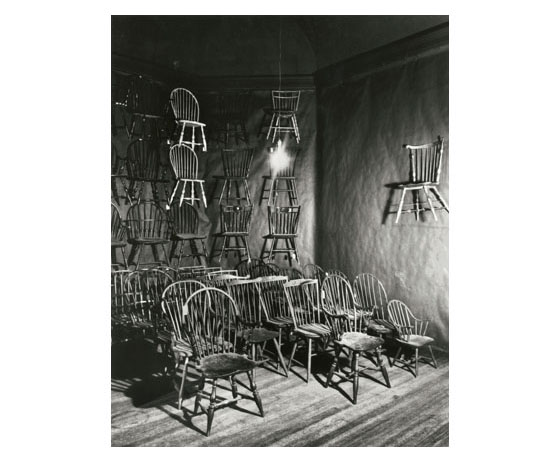
Andy Warhol, Raid the Icebox (detail), 1970
Parlay-Vous (an Aside, Sort of)
We arrived in Texas a few days prior to Conference Registration and then took off through driving rain for San Antonio, acting on the Parlay Principle of business travel that I learned from the late art critic and editor Gregory Battcock. Battcock and I, along with many others, were in 1970 the guests of collectors Dominique and John de Menil. Their daughter Christophe would later be the co-founder of the Dia Foundation, and Dominique herself would create the Menil Collection, a Houston Museum of some note.
The de Menils had sponsored an Andy Warhol exhibition at Rice University in Houston. It was called "Raid the Icebox with Andy Warhol," and Warhol merely selected stuff from the Rhode Island School of Design collection: a wall of chairs, hats and hatboxes, and so forth. It was clever indeed, since it represented art as curating or curating as art. But my pal Gregory, who loved to travel, parlayed his return trip to include a stop in Puerto Rico. (This is sometimes called triangulation.) He somehow commandeered a de Menil limo and had it driven onto the runway to stop the plane he needed. The Parlay Principle: if you are somewhere, use that occasion to go somewhere else.
Here is my most successful use of the Parlay Principle:
My first trip to Australia required a fueling stop at Fiji. We got out of the plane, traversed an odoriferous zone of tropical flowers, then through a gift shop (where I bought a pareu made in Malaysia) and back to the waiting room before we got on the jet. The aroma of those nocturnal tropical flowers lingered.
A few years later, I needed to go to a conference in Wagga-Wagga, which is in Australia. I thought: maybe I can stop in Fiji. I called my travel agent, Dui. It will only cost a hundred dollars extra, he said, and I know a great hotel for $75 a night. But I have another idea. One of the Qantas flights stops at Tahiti and then goes on to New Zealand before landing in Sydney.
Thus a simple flight to Australia for business became a South Pacific tour, using Perreault's Parlay Principle. New York to L.A. -- stopping overnight to see some friends -- then on to Honolulu; next day to Tahiti; then a gigantic catamaran to Tahiti's sister island of Moorea. A few days later landed in Auckland, where you could bungee-jump down the side of a 20-floor bank building for a fee. Rotorua: male Maori dances with great tattoos and an outdoor Victorian mineral bath, with a grid of temperatures and mineral contents. Napier, an art deco seaside resort constructed after a devastating mid-1930s earthquake. Sydney, Wagga. And, of yes, on the way back, Fiji with Hindu temples in sugarcane fields.
The Texas Taco Tour was simple by comparison.
* * *
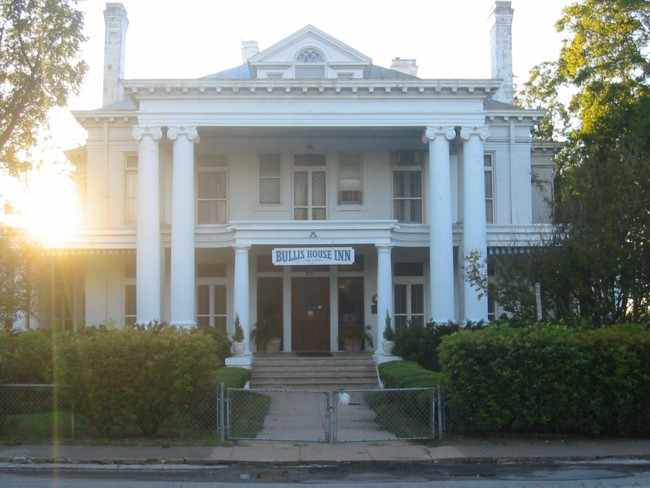
San Antonio, My San Antonio
In San Antonio, I was cured of tacos. I prefer the authentic Mexican pulled-pork, green-sauce soft tacos I get in the East Village. Tex-Mex is the "Mexican" food we know too well with everything topped by everything else in a mushy pile, even in San Antonio. However, I hasten to add, the scrambled eggs and crunchy tortilla strips at the Blanco Cafe made San Antonio totally worthwhile. Should I really begin to use lard for my scrambled eggs? Better not.
And we stayed in the 1909 Bullis House mansion, a B & B next to Fort Sam Houston. General John Lapham Bullis, a Civil War veteran, had been the Fort paymaster. Fort Sam Houston is where Apache Chief Geronimo was held. Bullis had something to do with his capture and so Geronimo's ghost haunts Bullis House, apparently taking the form of a whiff of cat perfume. And, oh yes, the Fort across the street was a Japanese and German internment camp during World War II.
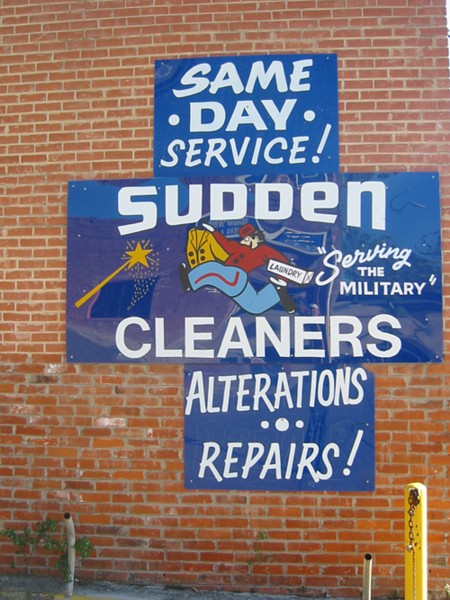
Tacked to the oaken front desk of the empty B & B was an e-mail printout I was tempted to steal, but thought I had better not since it did contain a dire alert. The writer was warning all women to beware of shady perfume salesmen in parking lots. They approach, offering brand-name bargains, and when you sniff the sample it turns out to be chloroform; you awake to find your purse, watch and jewelry gone.
We had dinner out with my buddy's old girlfriend's charming mom, and I had a taco sampler: hard, soft, and puffed, the latter a San Antonio specialty that in this incarnation resembled a soggy sponge.
I had been to San Antonio before, perhaps 20 years ago. Had I passed my future friend on his bicycle or driving his Camaro on his way to a radio station or a film-shoot? I remembered the WPA River Walk. You don't know it's there, snaking below street level through the empty downtown. But when I peeked over a railing there were no floating restaurants or tourist barges plying their way, as remembered, and the walks were as neutron-bomb empty as the streets above. Everyone was at the mall and I guess it wasn't tourist season. And, of course, I remembered the Alamo.
We did look up Matthew Drutt, formerly of the Menil Collection in Houston, now the new director of Artpace. Matthew's wife and my friend's bride-to-be had worked together on the staff of a major New York museum. Artpace, sponsored by a hot-sauce heiress, houses three or four resident artists at a time, and then their studios become the exhibition spaces. We got a peak at three installations in progress: Allison Smith's wooden horse for a Civil War reenactment; Katie Pell's "flaming" kitchen stove, and Chiho Aoshima's watercolor mural of the San Antonio skyline replete with manga eyes.
The building is a sleek conversion of a former Hudson dealership, and could easily be expanded to become the contemporary art museum that San Antonio sorely needs.
Then off to Austin to see the Ex-Girlfriend.
* * *
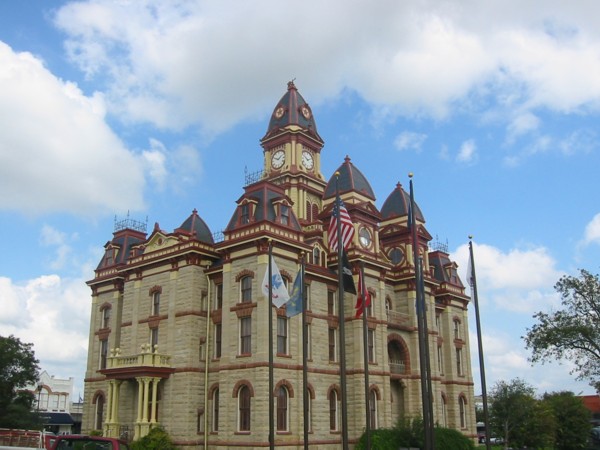
Lockhart Courthouse, Lockhart, Texas
Where's the Beef?
I insisted, with no resistance from my traveling companion, that we stop at Kreuz Market in tiny Lockhart for what everyone agrees is the best German-style barbecue in the universe, cooked over live-oak logs, sliced before your eyes and served on butcher paper with not a knife or fork in sight. You don't need them.
Lockport is basically an ornate courthouse surrounded by a necklace of buildings one-block deep, in the middle of the scary flat expanses of Texas. Where, one wondered, is the James Dean of Giant? Lockhart is one of the German settlements in Texas. But Kreuz Market was no longer hidden behind an unmarked door. We found it by the smell of smoke and meat. It had gone up-market and moved to the edge of Lockhart to accommodate the tourist buses, across the street from the town cemetery

Given the iffy nature of beef, no matter how tender, smoky, and emphatically sauceless, it is not a reassuring sight to spy the rather expansive cemetery, as, stuffed with melt-in-your-mouth brisket and salty sausage, you roll back to your rented car. As everyone says, pickles here count as vegetables. But you could, as I did, have added a healthy portion of German potato salad made with vinegar, bacon bits, and rendered bacon fat.
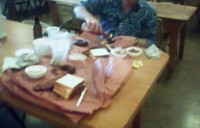
Brisket, sausages and white bread on butcher paper.
But was the beef as good as remembered? It can't be the same, but perhaps memory is to blame. The meat is no longer surrounded with enough smoke and cowboys. And -- here's the rub, or more correctly, the lack of rub --- you can go online and have it shipped. Get the brisket. And although no sauce is still available or required, I learned online that the German potato salad was added not long ago, in 1999.
* * *

Coffee Bar on Austin's Hippie Strip
Austin City Limits
In Austin, craft reappeared. The Ex-Girlfriend, who had been in several Austin-based films and a casting director too, was now a mom, writing scenarios. She had wed a blacksmith. My great-grandfather on the Gautier side was a blacksmith, so I was particularly interested. We visited the co-op studios, where a painter and a talented furniture-maker also held forth, and then to a stone-carver/sculptor who showed us a prize collection of Mayan chisels. The ceramicist wife who did traditional Japanese inlay was friendly, too.
Our Austin digs, inexplicably called the Hotel San Jose, was a converted motel on the old hippie strip. It features Dia-like, Chelsea-like sealed concrete floors and Eiffel chairs, and i-Pod stations. The Ex-Girlfriend, accustomed to putting up players from Hollywood, had recommended this coolissimo place.
Then off to Houston, to the Hilton -- which displayed a strangely overlooked Dale Chihuly chandelier in its lobby -- to contemplate the Craft Crisis. I had already learned on this trip that I can have nostalgia for a past I never had -- my friend's. Furthermore, not only is it true, as Thomas Wolfe wrote, that you can't go home again, you can't relive the perfect Texas brisket. Now I needed to prove that I could be cured of a nostalgia for the future -- a past invented by William Morris.
* * *

Panelists (projected) and Audience, 2006
Notes ona Conference
1. Andrew Wagner, formerly of Dwell, is introduced as the new editor of American Craft Magazine. After 30 years, Lois Moran is retiring.
2. Sculptor Martin Puryear gives the keynote speech. Beforehand, he wonders why he had been asked, but, always a charmer, he handles his assignment well. Did not show one slide of his own work, which may have left some in the audience totally in the dark about why indeed he had been asked. Certainly not just because he has a show coming up at MoMA or, as he confesses, has a guilty hobby of making traditional furniture for his own use. Clearly he has a particular liking for wood and for handwork. Was he invited because he is not afraid to use the word "craft"?
3. Houston Museum of Fine Arts director Peter Marzio offers a lively exposition of the history of the fine arts versus craft in Houston and tells us why craft has become a part of the museum's program. One wishes for similar local histories to flesh out and complicate the subject, which is far too often generalized.
4. Texas-style sauced BBQ and two-step and line-dancing (not by me) at the Houston Center for Contemporary Craft, where sculptor James Surls' excellent exhibition "Finding Balance: Reconciling the Masculine/Feminine in Contemporary Art and Culture" holds forth.
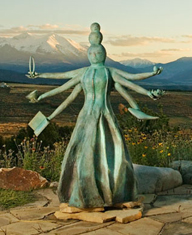
Charmaine Locke, (detail) Painting.
It breaks some rules. Surls himself has work in the show, as does his wife, Charmaine Locke. Plus there's work of two former directors of the Anderson Ranch, at Snowmass, Colorado, where Surls sometimes teaches. (Full disclosure requires me to note that I have taught there, too.)
In the catalogue there's a kind of summary of Leonard Shlain'spopularizing "Sex, Time, and Power: How Women's Sexuality Shaped Human Evolution" by the author himself. Here, since the exhibition is about the relationship between men and women, he omits his gay chapter, wherein one may learn that gay men have a 15% larger corpus callosum than everyone else. The corpus callosum connects left and right hemispheres of the brain, thus suggesting easier traffic between the opposing lobes and less specialization, perhaps explaining the proposed greater creativity of gay men.
And yet the art is on the whole exceptional, the theme (or themes) explored in a complicated way, and the pauses-for-thought unavoidable. Surls was motivated by two factors: he not only has a wife, he is the father of seven daughters, and an Internet search with one of them revealed that most women's organizations worldwide exist mostly toprotect women from men. I say break more rules and certainly let more artists like Surls curate exhibitions. Surls is a shamanistic sculptor who most typically works with found wood in the form of branches and trees and is not usually thought of as a craftsperson. Perhaps it takes a craft venue like the Houston Center to force art out of its rule-abiding box.
5. Glenn Adamson (of the Victoria and Albert) and Edward Cooke (of Yale) use their discussion to announce their new peer-review periodical, The Journal of Modern Craft, forthcoming in 2008 out of Great Britain. Can they rewrite craft history by reexamining what has already been written, but is not acknowledged? Can a peer-review periodical offering academic points to contributors rise above the conformist and the mundane? We certainly hope so.
6. My friend had a great idea. We played hooky late one afternoon to tour some Houston Outsider Art treasures: Cleveland Turner's Flower Man House, Jefferson Davis McKissack's The Orange Show, John Milovisch's Beer Can House and the Art Car Museum. Craft may overlap sculpture, but no one ever points out the craft used in Outsider Art. The spectacular Orange Show, for instance, required woodworking, tiling, metalwork. Is this blind spot because of the Craft World's fear of Folk Art -- although Folk and Outsider are very different -- or because craft, to be Craft, now must be schooled?

7. David McFadden, the bright chief curator of the Museum of the Arts and Design, reveals that institution's opening exhibition in its controversial new site, the former Edward Darrel Stone Gallery of Modern Art at Columbus Circle. The opener will be called "Making It: Materials, Process, Meaning." His point seems to be to avoid both the words "craft" and "design." Although some design objects show up in the slides, most of the objects are craft. So maybe a rose with no name is still a rose.
8. Curator Timothy Anglin Burgard of the Fine Arts Museum of San Francisco shows us how he has successfully integrated selected craft objects from their Sachs Collection into their fine-arts array.
9. Curator James Elaine of the Hammer Museum in L.A is puzzled, like Puryear, by his invitation to speak. The mystery is solved when he shows slides of his award-winning 2005 exhibition, "Thing." Many of the works use craft materials and techniques. By the way, Kristin Morgan's unfired clay, life-size automobile (from "Thing") is, next to works by Josiah McElheney, the most-shown image at the conference. What does this prove?
10. Brett Littman's panel seemed to upset a few people because of a handout called "New Paradigms in Curating Craft and Design: A Manifesto." Littman, that firebrand, is deputy director of P.S. 1 and a self-identified crafts patsy, having worked with me at UrbanGlass in Brooklyn. At this point he has also curated a number of craft and design exhibitions, most notoriously "Civic Matters," a Swedish-American continuous collaboration with no end or end-product. During the Q & A, my anonymous contribution to "The Manifesto" was publicly singled out by one university jeweler as being particularly outrageous: "Change the name of the Museum of Modern Art to the Museum of Modern Art, Craft and Design." Irony, alas, will always fail. (And I had always liked her work!) Perhaps, as now seems to be the fashion, the ACC should also drop "craft" from its name and begin calling itself the American Arts Council. This would please a lot of collectors and, alas, craft artists too.
* * *
The conference, however, can best be judged by what it did not include: no discussion of whether the ACC mission is still valid, no discussion of the use of computers in craft-making, no discussion of the Internet as a salesroom for craft, no discussion of the bland ACC Website, no discussion of how the public can be educated to embrace craft values, no discussion of how to improve the taste level of the craft fairs that give craft such a bad name.
If the ACC mission is to educate, then the mission is in trouble.
If the mission should be to encourage and preserve handmade art that uses traditional craft forms, techniques and materials, then one might wonder if craft-media groups such as G.A.S., S.N.A.G., N.C.E.C.A. are already doing that, plus providing peer-to-peer forums, pep rallies, and technical and career information.
American Craft Magazine is still important because of the possibility of cross-referencing among ceramists, glassworkers, woodworkers, weavers, metalsmiths and the promotion of a common cause. More cross-disciplinary conferences are needed. Twenty years was too long to wait. But why not hold a conference of representatives from all the media groups?
On the other hand, perhaps the American Craft Movement is over. It has been around for over 80 years. Did Cubism or Surrealism or Abstract Expressionism last that long?
Answer: Craft is not an art movement. Craft is a belief system, like art itself.

To receive Automatic Artopia Alerts when new entries are posted: contact perreault@aol.com.

The Price Is Right
How cynical can I be? Is it an accident that not too long after the Edward Broida Collection display at MoMA, which included a whole room of Ken Price ceramic "gloop" works, Matthew Marks Gallery schedules an exhibition of more of the same? Business is business. The Broida gloops are now in the MoMA permanent collection.
The gloops have no openings, so they are not vessels. Cups used to be what Price was famous for, and we loved them for their references and wit. The gloops, except for a giant bronze (at Matthew Marks, 522 West 22nd Street, to Nov. 4), are made of clay that has been painted rather than glazed. They are Arps in color or shiny, speckled ca-ca, outsize Chelsea penthouse poodle poop. The latter association, which makes them funny -- unlike Piero Manzoni's classic canned excrement -- shows that you cannot totally defunk one of the primo California funksters of years gone by.
A big display of Price's previously unexhibited drawings gives the show away. Cups lurk here and there. Also, the openings of previous vessels are compared to vaginas. Anyone who knows ceramics knows that vessels are bodies and their openings are vaginas, anuses, mouths. Oh, what a surprise. That is part of their charm. But I guess sculpture people need to be shown this, graphically.
Discounting the vessel drawings, the stealth tactic works. Price is no longer a ceramic artist. His prices probably reflect this. On the other hand, instead of competing with Peter Voulkos, Robert Arneson, and Ron Nagel, he now has to compete with Tony Smith, Donald Judd, and Richard Serra. How will his gloops hold up?
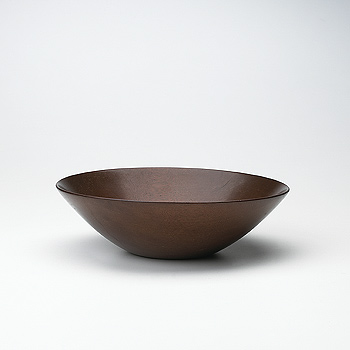
James Prestini: Untitled (1925-1954?)
CanCraft Have Class?
A younger craftsmen, glassblower Josiah McElheny, became a sculptor when he had his first show at Andrea Rosen. He was subsequently in a Whitney Biennial and then ascended to the MoMA permanent collection. As director of UrbanGlass in Brooklyn, I facilitated McElheny's first exhibition in N.Y. in 1994, but that didn't count: the curse of craft, I suppose. The exhibition does not appear on the artist's official biography. But now, McElheny has won a MacArthur Fellowship.
McElheny is indeed extremely talented. Not only is he a master glassblower, he has the brains to marry his skill to narrative-art perspectives and art-about-art points of view. The latter are not new, but the marriage is surprising enough to impress the informed. I wish I could say: call it craft, call it sculpture, a rose by any other name is still a rose.
I used to say, rather sarcastically, that the only difference between craft and art is that you are allowed to handle craft before you buy it -- and, even more important, art costs more.
I gave up trying to convince both crafters and sculptors that the craft/art muddle is a language mistake. It is not a question of art versus craft. Craft is art as much as photography, performance art, painting, et al., are Formulating art versus craft is like proposing fruit versus apples, meat versus ham. If you like oppositions, you should be opposing sculpture and craft. And, of course, we have not addressed the idea of hierarchy, or if there really needs to be one. Some might put craft at the top and conceptual art at the bottom. But are apples better than pears?
Then again, one could say, as former MoMA curator Robert Storr once did at a Glass Art Conference, that craft and art are engaged in different games, so why would MoMA be interested? You could have heard a pin drop. Or a blowpipe.
I myself would rather say that craft artists are competing with a different set of ancestors than sculptors are. A ceramist is competing with George Ohr; a sculptor is competing with David Smith.
The C-Word
As it happens, this week I am off to the American Craft Council's Leadership Conference in Houston, where I am sure the muddle will hold forth, particularly now that there is no American Craft Museum, but instead something called the Museum of Arts and Design (M.A.D.).
Mad, indeed. Just because currently there is a rampant fear of the C-word doesn't mean that craft will go away. I think some artists will continue to make things by hand, referencing utilitarian forms and using craft-based processes, but the word "craft" is now too hard a sell. Are the values associated with the American Craft Movement irrelevant? And if so, why?
In general, these values are:
The preservation and the encouragement of traditional craft techniques and the use of traditional craft materials.
The use of utilitarian forms.
The valorization of the designer and the maker as one.
This does not mean that individual expression and originality are disdained. In fact, within the above brief, they are more difficult than in unfettered and perhaps overtly self-indulgent object-making.
There can be no doubt that most of what is called craft is garbage; but the same can be said for painting or sculpture or photography. One walk through the Washington Square Outdoor Art Show never made anyone give up on painting (although nowadays, one walk through Chelsea might).
Since there is a conservative, mindless, focus-group-generated trend to drop the C-word from the names of museums and even schools, my proposal is that the Museum of Modern Art -- which once operated a craft program for G.I.s; where genius James Prestini, the turned-wood vessel-maker, had a solo exhibition in 1949; which includes George Ohr in its design collection; which now owns work by Kenneth Price and Josiah McElheny -- should seize the opportunity and change its name to the Museum of Modern Art and Craft.

Paintings?
Speaking of paintings (which really and truly I have not given up on, since I sometimes make paintings myself), two exhibitions worth seeing are Alfred Jenson's classic number paintings at Pace (545 West 22nd Street, to Oct. 28) and Matthew Ritchie at Andrea Rosen (525 West 24th Street, to Oct. 28). Jensen (1903-81) could be mistaken for an outsider artist, if he hadn't worked so large and been so educated. The Mayan calendar? The breadth of his numerical craziness and its odd beauty still astounds.
Richie's exhibition is called "The Universal Adversary" and comes with a quote from Ezekiel:
Their appearance and their work was as if a wheel within a wheel; as for their rings, they were so high they were dreadful and their rings were full of eyes, round about them four. And when the living creatures went, the wheels went with them for the spirit of the living creature was in the wheels.
This new installation of paintings, lightboxes and cut-out sculpture exhales the fiery breath of the apocalypse. Ritchie now pulls ahead of the pack of painters seen at the Whitney's "Remote Viewing" exhibition last year.
For an Automatic Artopia Alert when new entries are posted, email: perreault@aol.com
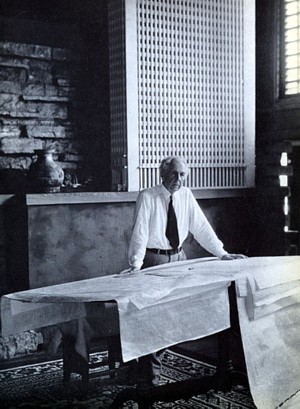
Things You Wish You Had Never Found Out
Is a masterpiece still a masterpiece once you have discovered that the architect of record was notoriously, dangerously lacking in engineering skills? That the architect wore elevator shoes? That he was a hypocrite about homosexuality?
Frank Lloyd Wright was antigay when it came to what he called that "Pansy Patch of the Museum of Foreign Art," as exemplified byPhilip Johnson and Henry-Russell Hitchcock at MoMA, but covertly allowed his majestic, Russian-born wife to initiate homo-hookups among his Fellowship Boys to keep them from bouncing the local dairy maids. Also, though he also favored gay men as staff leaders, in the '50s he held an antihomosexuality "show trial" of his most trusted helper.
A new tome spills the beans about Mr. Wrong: The Fellowship, The Untold Story of Frank Lloyd Wright & the Taliesin Fellowship by Roger Friedland and Harold Zellman (Regan). Enormously detailed, this is a book for anyone interested in modern architecture, cults and esoterica, gay history, and the psychologyof the artist as savior. And although the authors do not theorize or editorialize -- a lack of theory is the only fault -- they are unflinching in their methodical, mostly chronological exposure. Read it and weep. Not only are there walk-ons by Nicholas Ray and Anthony Quinn (both briefly Fellows), but also appearances by Charles Laughton, Marilyn Monroe, and Joseph Stalin's daughter.
Friedland is a professor of religious studies and sociology with an interest in "the intesections between culture, religion, and eroticism," all of which come into play in what is a long-needed tabulation of Wright's failings. Zellmanis an historian of modern architecture and communitarian movements, as well as a practicing architect. It is because of the last that we gain fresh insights into Wright's reliance upon on-site improvisation and dependence on construction workers to fill the dangerous gaps in his architectural plans.
Based upon an enormous amount of research, The Fellowship is not so much a revisionist view of Wright -- the value of his architecture, aside from the master's lack of engineering skills, is here apparently incontestable -- but a new biographical context that factors in a hidden history of the esoteric and the sexual. And although monsters are always interesting, if this were a movie, you wouldn't believe it.
And is his architecture incontestable?

Getting It Wright
According to Friedland and Zellman in their straightforward investigation, Wright's Fellows could not define what the Masterbuilder meant by Organic Architecture. They were actually not taught very much, but used as freelabor.Being within his magnificent presense was considered enough to create art by absorption. I takeOrganic Architecture to be building from the inside out, starting from living space (useful or not); truth to humble materials; and adjustment to the site. And not form follows function, but the identity of form and function.
These principles he mostly faked. Architecture, like so much else, is written by photography. It if doesn't make a pretty picture, a building doesn't exist. Placing a house directly over a very loud waterfall is stupid, as in Fallingwater, but it makes for good photos.
Emphasizing the horizontal for houses in the prairie and the desert makes some sense. But what sense is there ingetting rid of roof gutters? Unless you know that the spiral structure of the Guggenheim Museum in New York City was meant to pleaseHilla Rebay, the Theosophist in charge, that fine shape makes no sense at all, particularly in regard to the surrounding environment. Looking at paintings while walking up a six-story spiral ramp is stupid.
We are used to the Guggenheim now, where, oddly enough, representational paintings look better on thecurvedwalls above the slanting floors than do the non-objective paintings that the founding curator preferred. Wright, always against painting, wanted the art on the floor, leaning against the walls -- or, as he said about his houses, no art at all. His architecture was the art. Truth to materials? Honest structure? Forget about it. The Guggenheim is made mostly of Gunite; the same stuff they still use for swimming pools. And the various levels of the ramp are not actually cantilevered.
Wright's biggest playing field was domestic architecture, and late in his career he tried to launch his populist, affordable Usonian house. I was once thrilled to visit curator Ellen Johnson's restored Usonian house in Oberlin, Ohio. And I have seen Wright'sUsonian house in Staten Island, but was not impressed. Wright did innovate the open plan, but he was probably better at housing for the wealthy than for the middle class. I did attend a conference at Wright's 1937 Wingspread outside of Racine. The central living space is like a giant teepee, and the hallways and the Johnson family bedrooms all have extremely low ceilings. Why? To increase the drama of arriving in the giant living room, or because the Masterbuilder was (he claimed) five-feet-eight-and-a-half inches tall?
Is that with or without elevator shoes?
And his furniture! He preferred built-ins and hated when clients brought their junk into his houses. The chairs he did make are uncomfortable. I have sat on some. In his Autobiography he admits that he had many black-and-blue marks from sitting in his own furniture.
When Gurus Collide
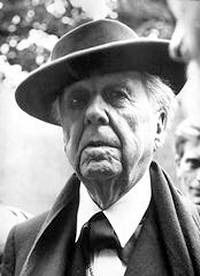
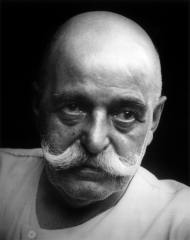
The news set forth in The Fellowship is the unexpectd role of the Fellowship or apprenticeship systemin Wright's later career and, through wife Olivanna, the interplay with the esoteric. Strapped for cash during the Great Depression and his innovative buildings apparently all behind him, Wright borrowed the idea of taking on "fellows" for a fee. Working for Wright cost more than the tuition for an architectural degree. He got the idea from Dutch acolyte Hendricus Wijdeveld, with a good helping of Arts and Crafts rhetoric from Charles Ashbee (founder of the important British Handicraft Guild) and Elbert Hubbard, who created the Arts and Crafts Roycroft colony in Aurora, New York. If you read Wright's Autobiography you will smell the inflated pomp of Hubbard's bombastic lecture and essay style. At first Wright copied Hubbard's long hair and style of dressing. Hubbard himself was mimicking Oscar Wilde.
We did not know that Wright's beloved mentor Louis Sullivan was probably gay. We did already know that early on, Wright faced scandal (he abandoned his family and ran away with the wealthy Mamah Cheny) and tragedy. Mamah and her two children were killedby a crazed servant who nailedTaliesin shut except for the bottom half of a Dutch door, set fire to the house, then axed each victim when he or she crawled through the opening.
And we knew that the illustrious wife who followed -- Olgivanna Hinzenberg -- was a major disciple of Georgi Ivanovich Gurdjieff, the 20th century magus.
Gurdjieff claimed to be the repository of certain secret traditions and spiritual techniques, convincing a wide range of culturati from Margaret Anderson and Jane Heap (editors of The Little Review, where Joyce's Ulysses first appeared in the U.S) to Lincoln Kirstein of the New York City Ballet. Although L. Ron Hubbard, founder of Scientology,started as a science fiction writer, Gurdjieff ended as one: Beelzebub's Tales to His Grandson is unreadable unless you realize that like the Zohar or some Sufi texts, it is the reading of the text that works on you as much as the meanings.
But I didn't know that Gurdjieff and Wright, who didn't exactly hit it off, met more than once; that Wright's wife Olgivanna struggled to make Taliesin West a Gurdjieff Center. The Fellowship Boys were instructed in Gurdjieff's spiritual dance-system and public performances were given at Taliesin. At the end -- Mr. Wrong, dead -- the handsome Olgivanna won her battle, but by then she had not only inappropriately assumed her husband's architectural mantle, but decided she could supercede G.'s teaching with her own brand of spiritual work.
Olgivanna certainly did not have her husband's aesthetic sense. I saw Taliesin West before it had been restored and cleared of her kitschy amendments. Not good. And although I did not then really know how far the Wright Cult and the post-Gurdjieff Cult had progressed, I thought the guided tour weird, the apostles zombie-like.
By most accounts, Olgivanna never had G's inner light. She could replicate the encoded dances, but she could not read minds, cause orgasms and erections by remote, and certainly, for all her meddling and match-making, was not known to be able to startle disciples into higher consciousness -- or create a soul by an insult, a look, or the assignment of meaningless work. The imposition of intentional suffering, however, she seemed to know too much about. Yet we in Artopia (since Artopia is not Utopia, and certainly not Usonia) surely understand that the soulis not so easily confirmed, nor does spiritual progress, to put a fine theological point on it, necessarilyreveal itself immediately.
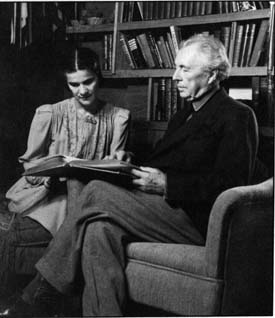
Mr. and Mrs. Wright
Frank Lloyd Reich
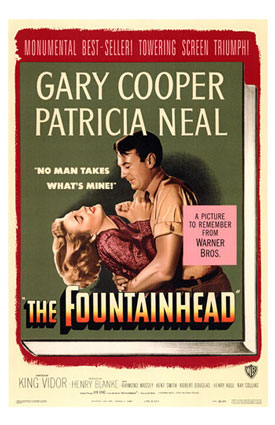
Although Wright could charm when necessary, Friedland and Zellman make it clear, through the extensive use of interviews and the Wright Archives themselves, that the Great Man was wildly self-centered, monomaniacal, arrogant, incredibly vain, and abusive to his wives, his step-daughter, his daughter.And paranoid? Was Phillip Johnson really out to get Wright? Johnson had attempted to form an American Nazi Party, proclaiming that the Third Reich was the future of architecture. Mies van der Rohe, whom Johnson championed and Wright despised,had been, we now know, a Nazi collaborator, no doubt trying to save the Bauhaus, but a collaborator nonetheless.
Like Henry Ford, another great American, Wright thought that Hitler was on to something good. If London were leveled, a British branch of Wright's "visionary" Broadacre City could easily be built. You would have thought Johnson and Wright would have had a common cause.
Yet there is no explaining it. Later Wright was constantly under Hoover-watch as a Soviet symp. He had made pro-Soviet statements even after Stalin's Moscow Trials. His dream was to have Usonia, composed of Wright-controlled Broadacre Cities, secede from the Union, leaving New York and Chicago to the wolves. Or did he mean Jews?
Wright'sbeliefs seemed to be centered around America First Fascism; he belonged to the American First Committee, advised his Fellows to refuse to be drafted during the Second World War, andhe counted among his friend Charles Lindbergh, a political hero and possible American savior. Yes, Lindbergh -- who accepted a metal and a sword from Goering and, in an infamous speech in Des Moines, Iowa, in 1941, said:"Their greatest danger lies in [the Jews'] large ownership and influence in our motion pictures, our press, our radio, and our government. We cannot blame them for looking out for what they believe to be their interests, but we also must look out for ours."
Although Wright had many Jewish patrons and allowed some Jewish apprentices (when they were rich enough, and he could get his hands on their money), he was clearly an anti-Semite.
Wright was the great man, the greatest architect in the universe, the fountainhead that inspired Ayn Rand's The Fountainhead. Although when that author, a dangerous right-wing nut-case herself, finally met him, she thought he was insecure and dishonest and was appalled that the Fellows ate lesser food than Mr. and Mrs. Wright and their guest.) The Fountainhead movie which I saw by accident last week on Turner Classic Movies put the radiant Patricia Neal and the ruggedly handsome and tall Gary Cooper to evil use. King Vidor's direction and the Steiner music are perfect. It is the ideology that is ludicrous and, like Wright's ideology, dangerous.
Our authors, Friedland and Zellman, do allow that Wright was bipolar. Is that an excuse? Hitler was probably bipolar too. Does being a 19th-century midwesterner excuse Wright's isolationist, antisemitic, antiurban world view? I don't think so. I cannot look at any of his buildings now without thinking of egotism and hate.
Of course, International Style modernist architecture ironically would not exist without the early influence of maverick Wright, but that establishment-approved style, according to Our Hero, turned out to be soulless, thoroughly homosexual, and anti-American. Those pansies at MoMA again!
In short, Mr. Wright was Mr. Wrong. We are not amused by his duplicity, loan-scoffing, tax-cheating, and thebullying and brow-beating of all within his kingdom. He got onany ship that was leaving port, followed any scent in the wind as long as it helped his career. I suppose he might have said -- like one-time Nazi party member, sopranoElisabeth Schwarzkopf -- "I only lived for art."
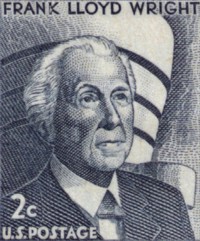
FOR E-MAIL NOTICE OF ARTOPIA ENTRIES AS THEY ARE POSTED WRITE PERREAULT@AOL.COM
AJ Ads
AJ Blogs
AJBlogCentral | rssculture
Terry Teachout on the arts in New York City
Andrew Taylor on the business of arts & culture
rock culture approximately
Laura Collins-Hughes on arts, culture and coverage
Richard Kessler on arts education
Douglas McLennan's blog
Dalouge Smith advocates for the Arts
Art from the American Outback
For immediate release: the arts are marketable
No genre is the new genre
David Jays on theatre and dance
Paul Levy measures the Angles
Judith H. Dobrzynski on Culture
John Rockwell on the arts
Jan Herman - arts, media & culture with 'tude
dance
Apollinaire Scherr talks about dance
Tobi Tobias on dance et al...
jazz
Howard Mandel's freelance Urban Improvisation
Focus on New Orleans. Jazz and Other Sounds
Doug Ramsey on Jazz and other matters...
media
Jeff Weinstein's Cultural Mixology
Martha Bayles on Film...
classical music
Fresh ideas on building arts communities
Greg Sandow performs a book-in-progress
Exploring Orchestras w/ Henry Fogel
Harvey Sachs on music, and various digressions
Bruce Brubaker on all things Piano
Kyle Gann on music after the fact
Greg Sandow on the future of Classical Music
Norman Lebrecht on Shifting Sound Worlds
publishing
Jerome Weeks on Books
Scott McLemee on books, ideas & trash-culture ephemera
theatre
Wendy Rosenfield: covering drama, onstage and off
Chloe Veltman on how culture will save the world
visual
Public Art, Public Space
Regina Hackett takes her Art To Go
John Perreault's art diary
Lee Rosenbaum's Cultural Commentary
Tyler Green's modern & contemporary art blog
